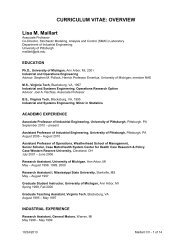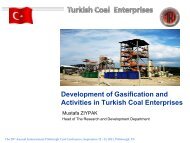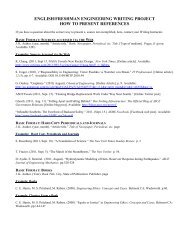Abstract Booklet 2006 - Swanson School of Engineering - University ...
Abstract Booklet 2006 - Swanson School of Engineering - University ...
Abstract Booklet 2006 - Swanson School of Engineering - University ...
Create successful ePaper yourself
Turn your PDF publications into a flip-book with our unique Google optimized e-Paper software.
these materials is likely to lead to the discovery <strong>of</strong> new and improved materials for hydrogen<br />
storage that meets the challenging specifications set by the US DOE.<br />
In the traditional rare earth intermetallic compounds, hydrogen is stored in the interstitial<br />
sites <strong>of</strong> a crystal. The heat <strong>of</strong> formation <strong>of</strong> the hydrides is typically about -15 kJ/H, the<br />
plateau pressures can be fine-tuned by modifying the alloy compositions, the kinetics <strong>of</strong><br />
hydrogen absorption-desorption are fast ( ~200 sec.) and the volumetric hydrogen capacity is<br />
reasonably high. However, the gravimetric hydrogen storage capacity is only about 1.5 wt%,<br />
far short <strong>of</strong> DOE goals. Metallic magnesium chemically reacts with hydrogen to form stable<br />
MgH 2 with a heat <strong>of</strong> formation <strong>of</strong> ~-37 kJ/H. The theoretical gravimetric capacity is as high<br />
as 7 wt%. However, the kinetics <strong>of</strong> decomposition even in microcrystalline samples is<br />
extremely slow (several thousand seconds at ~300°C). Our recent research work has shown<br />
that (1) kinetics <strong>of</strong> decomposition <strong>of</strong> the hydride increases when the material is reduced to<br />
the nanocrystalline size through mechanical milling technique and (2) Addition <strong>of</strong> small<br />
amounts (~2 wt%) <strong>of</strong>, for example, nanocrystalline iron modifies the plateau pressure<br />
significantly. More recently, we have begun synthesis, characterization and hydrogen<br />
adsorption studies <strong>of</strong> Microporous Metal Organic Frameworks (MMOFs). These materials<br />
are composed <strong>of</strong> various metals, including selected group-1 and group-2 light elements and<br />
transition metals and sp 2 -carbon based ligands, which form the internal surfaces <strong>of</strong> the pores.<br />
We have synthesized several MMOF materials with a number <strong>of</strong> metals and organic ligands,<br />
and studied their hydrogen adsorption properties at room temperature as well as at low<br />
temperatures (78 K). For instance, we found that the hydrogen storage capacity is about 3<br />
w% and 2.25 w% at 78 K and decreases to about 0.29 w% and 0.5 w% at room temperature<br />
for [Co 3 (bpdc) 3 bpy] 4DMF H 2 O (bpdc = biphenyldicarboxylate) and Cu 3 BTC (BTC =<br />
Benzene-1,3,5-tricarboxylate), respectively, at hydrogen pressures <strong>of</strong> ~30 atm. The hydrogen<br />
uptake appears to be related, in part, to the pore size and pore structure. Thermal stability,<br />
pore structure and hydrogen storage characteristics <strong>of</strong> these and other related MMOF<br />
materials will be presented. We have performed atomistically-detailed modeling <strong>of</strong> H 2<br />
adsorption in various MMOF materials and have compared these theoretical predictions with<br />
experimental data. We have computed both the adsorption isotherms and isosteric heats <strong>of</strong><br />
adsorption at different temperatures. In general we find qualitative agreement between<br />
simulations and experiments. The simulations indicate that the most attractive sites for<br />
adsorption are near the corners <strong>of</strong> the frameworks, close to where oxygens are bound to the<br />
metal atoms. Calculations indicate that substantially higher heats <strong>of</strong> adsorption are needed to<br />
effectively store hydrogen at room temperature.<br />
Supported by: US DOE Grants: DE-FC26-05NT42446 and DE-FG02-04ER83886<br />
12-1<br />
SESSION 12<br />
GLOBAL CLIMATE CHANGE:<br />
GEOLOGIC CARBON SEQUESTRATION – 2<br />
The Use <strong>of</strong> Water Injection for CO 2 Sequestration in Coalbeds<br />
Miguel Tovar, Shahab Mohaghegh, West Virginia <strong>University</strong>, USA<br />
Carbon capture and storage in geologic formations has been proposed as a global warming<br />
mitigation strategy that can contribute to stabilize the atmospheric concentration <strong>of</strong> carbon<br />
dioxide, the anthropogenic gas with the largest greenhouse effect. Particularly in the US, the<br />
storage <strong>of</strong> CO 2 in unmineable coalbeds is an attractive prospect due to the large amount <strong>of</strong><br />
coal reserves and the possibility <strong>of</strong> enhanced coalbed methane recovery. This study<br />
introduces a new strategy for the prevention <strong>of</strong> post-sequestration CO 2 seepage to the surface<br />
from the CBM (CoalBed Methane) formations that is named the “Nature’s Sequestration<br />
Technique”. The idea is to retain the adsorbed CO 2 in the coalbed formation by having<br />
formation water filling the cleat system. Coalbed formations have the capacity to retain<br />
methane adsorbed on its surface through the geologic time under an appropriated pressure<br />
condition. This pressure condition is mainly established by water contained in the fracture<br />
network (the cleat system). We can take advantage <strong>of</strong> this natural occurrence in order to<br />
restore the system’s original conditions by filling the cleat system with water and having<br />
CO 2 adsorbed on the matrix instead <strong>of</strong> methane. Using a commercial numerical simulator<br />
and data representative <strong>of</strong> the Appalachian basin region; we investigate whether or not the<br />
presence <strong>of</strong> water on the cleats helps to sequester CO 2 in a coalbed for a long period <strong>of</strong> time<br />
without significant seepage. Several scenarios were considered for this study, with variations<br />
<strong>of</strong> depth, flow mechanism and nature <strong>of</strong> potential fracture that would work as a conduit for<br />
the seepage <strong>of</strong> CO 2 to the surface. Results show that water filling the coal cleat system<br />
decreases significantly the amount <strong>of</strong> CO 2 seeped to the formations above the target<br />
formation.<br />
12-2<br />
Numerical Modeling <strong>of</strong> CO 2 Sequestration in Unmineable Coal Seams<br />
Guoxiang Liu, Andrei Smirnov, West Virginia <strong>University</strong>, USA<br />
Numerical modeling <strong>of</strong> CO 2 sequestration in deep unmineable coal seams can be used<br />
for long term predictions <strong>of</strong> storage capacity <strong>of</strong> these reservoirs, as well as enables one<br />
to analyze possible CO 2 escape routes. In addition to this, the computations can<br />
provide estimates on the possibility <strong>of</strong> residual methane recovery in CO 2 sequestration<br />
operations. The process <strong>of</strong> CO 2 transport in a coal seam can be influenced by many<br />
factors, such as bounding layers permeabilities, porosities, fracture densities, etc.<br />
In this study a series <strong>of</strong> computer simulations was conducted with a purpose <strong>of</strong><br />
predicting CO 2 transport in a multi-layer environment <strong>of</strong> typical unmineable coal<br />
seams. The parameters <strong>of</strong> three typical coal basins were considered as examples: San-<br />
Juan, Appalachian, and Powder River basins. In the majority <strong>of</strong> cases it was presumed<br />
that the upward migration was limited by the lowest permeability layers. An opensource<br />
OpenFOAM CFD solver (openfoam.org) was used in this study to analyze CO 2<br />
transport in coal seams. Darcy’s diffusion term was added into the solver, and mass<br />
injection was modeled within the framework <strong>of</strong> compressible flow. To facilitate the<br />
analysis <strong>of</strong> more complex layer formations in reservoirs a voxel-based geometric<br />
design system was adapted and interfaced with the OpenFOAM and TOUGH2<br />
simulators. The study can provide long term projections for the CO 2 sequestration<br />
operations in known coal seams.<br />
12-3<br />
Determination <strong>of</strong> Coalbed Methane Potential and Gas<br />
Adsorption Capacity in Western Kentucky Coals<br />
Sarah Mardon, Kathy G. Takacs, James C. Hower, Cortland F.Eble, <strong>University</strong> <strong>of</strong><br />
Kentucky, USA<br />
Maria Mastalerz, Indiana <strong>University</strong>, USA<br />
The Illinois Basin has not been developed for Coalbed Methane (CBM) production. It is<br />
imperative to determine both gas content and other parameters for the Kentucky portion <strong>of</strong><br />
the Illinois Basin if exploration is to progress and production is to occur in this area. This<br />
research is part <strong>of</strong> a larger project being conducted by the Kentucky Geological Survey to<br />
evaluate the CBM production <strong>of</strong> Pennsylvanian-age western Kentucky coals in Ohio,<br />
Webster, and Union counties using methane adsorption isotherms, direct gas desorption<br />
measurements, and chemical analyses <strong>of</strong> coal and gas. This research will investigate<br />
relationships between CBM potential and petrographic, surface area, pore size, and gas<br />
adsorption isotherm analyses <strong>of</strong> the coals. Maceral and reflectance analyses are being<br />
conducted at the Center for Applied Energy Research. At the Indiana Geological Survey, the<br />
surface area and pore size <strong>of</strong> the coals will be analyzed using a Micrometrics ASAP 2020,<br />
and the CO 2 isotherm analyses will be conducted using a volumetric adsorption apparatus in<br />
a water temperature bath. The aforementioned analyses will be used to determine site<br />
specific correlations for the Kentucky part <strong>of</strong> the Illinois Basin. The data collected will be<br />
compared with previous work in the Illinois Basin and will be correlated with data and<br />
structural features in the basin. Gas composition and carbon and hydrogen isotopic data<br />
suggest mostly thermogenic origin <strong>of</strong> coalbed gas in coals from Webster and Union<br />
Counties, Kentucky, in contrast to the dominantly biogenic character <strong>of</strong> coalbed gas in Ohio<br />
County, Kentucky.<br />
12-4<br />
Effects <strong>of</strong> Structural Rearrangements on Sorption Capacity <strong>of</strong> Coals<br />
Vyacheslav Romanov, Yee Soong, Robert Warzinski, Ronald Lynn, DOE/NETL, USA<br />
Recently, the problems in practical application <strong>of</strong> experimental data and modeling to<br />
the sequestration <strong>of</strong> carbon dioxide in coal seams and the concurrent enhanced coalbed<br />
methane (ECBM) recovery have underscored the need for new approaches that take<br />
into account the ability <strong>of</strong> coal for structural rearrangements. Areas <strong>of</strong> interest include<br />
plasticization <strong>of</strong> coal due to CO 2 dissolution, the effect <strong>of</strong> coal swelling on estimation<br />
<strong>of</strong> the capacity <strong>of</strong> a coal-seam to adsorb CO 2 (adsorption isotherm), and the stability <strong>of</strong><br />
the CO 2 saturated phase once formed, especially with respect to how it might be<br />
affected by changes in the post-sequestration environment (environmental effects).<br />
Coals are organic macromolecular systems well known to imbibe organic liquids and<br />
carbon dioxide. CO 2 dissolves in coals and swells them. The problems become more<br />
prominent in the region <strong>of</strong> supercritical CO 2 . We investigated the effects <strong>of</strong> moisture<br />
content and pressure cycling history on temporal changes in the coal sorptive capacity<br />
for a set <strong>of</strong> Argonne premium coals. The samples were tested as received, dried at<br />
80°C for 36 hours, and moisture equilibrated at 96-97% RH and 30°C for 48 hours.<br />
The powders were compared to core samples. Additionally, plasticization <strong>of</strong> coal<br />
powders was studied by high pressure dilatometer.<br />
12-5<br />
Sorption <strong>of</strong> Gases by Argonne Premium Coals at Supercritical Pressures<br />
Richard Sakurovs, Stuart Day, Steve Weir, Greg Duffy, CSIRO Energy Technology,<br />
AUSTRALIA<br />
Modelling the sorption properties <strong>of</strong> coals for carbon dioxide under supercritical<br />
conditions is necessary for accurate prediction <strong>of</strong> the sequestering ability <strong>of</strong> coals in<br />
seams. We present recent data for sorption curves for three dry Argonne Premium<br />
coals using a gravimetric system, and apply a recently developed model to the fitting<br />
<strong>of</strong> the excess sorption by these coals <strong>of</strong> carbon dioxide, methane and nitrogen at two<br />
different temperatures at pressures up to 15MPa. The model is unique in that it uses<br />
gas density rather than pressure as the main variable. It is a modified Dubinin-<br />
Radushkevich (DR) equation, using adsorbed phase density rather than saturation<br />
pressure as the upper limit. The fit <strong>of</strong> this model is generally around 1% <strong>of</strong> the sorption<br />
capacity. The sorption capacity <strong>of</strong> the coal is found to decrease with increasing<br />
temperature, which disagrees with expectations from simple models <strong>of</strong> coal sorption<br />
that predict a sorption capacity that is independent <strong>of</strong> temperature. This means that<br />
sorption capacity should not be considered a direct measure <strong>of</strong> the surface area <strong>of</strong> coal.<br />
10














